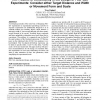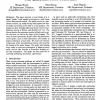3071 search results - page 82 / 615 » Explanatory Design Theory |
EGOV
2007
Springer
15 years 4 months ago
2007
Springer
The EU is currently modernizing customs legislation and practices. Main pillars in the new vision are an intensive use of IT (Customs becomes eCustoms), partnerships between Custom...
CHI
2009
ACM
15 years 2 months ago
2009
ACM
An intriguing anomaly of the usual way of designing Fitts’ law experiments in experimental psychology and HCI is exposed: experiments are traditionally designed so as to careful...
ICEIS
2003
IEEE
15 years 3 months ago
2003
IEEE
: In the traditional classroom, students learned to depend on tutors for their motivation, direction, goal setting, progress monitoring, self-assessment, and achievement. A fundame...
CLUSTER
2002
IEEE
15 years 3 months ago
2002
IEEE
Computational Grids are large scale computing system composed of geographically distributed resources (computers, storage etc.) owned by self interested agents or organizations. T...
ICRA
1999
IEEE
15 years 2 months ago
1999
IEEE
Abstract: This paper presents a novel design of a Jiegged "spider" robot capable of moving in a wide range of two-dimensional tunnels. The spider moves in a quasistatic m...


